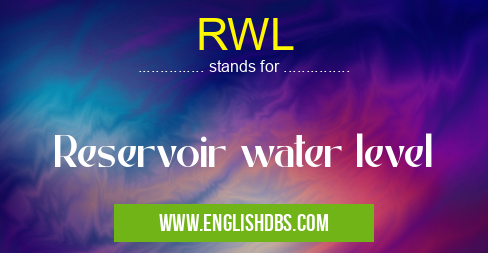What does RWL mean in UNCLASSIFIED
Reservoir water level is a measurement of the amount of water present in a reservoir. It is essential to monitor this as it can be used to plan and manage the use of water resources or to ensure that reservoirs do not become depleted. In addition, it can be utilized when predicting floods, for energy generation, in navigation purposes and for farming activities.

RWL meaning in Unclassified in Miscellaneous
RWL mostly used in an acronym Unclassified in Category Miscellaneous that means Reservoir water level
Shorthand: RWL,
Full Form: Reservoir water level
For more information of "Reservoir water level", see the section below.
Explanation
Reservoirs are man-made systems that collect surface runoff from rainfall and snowmelt, resulting from natural processes. The resulting volume is known as a reservoir water level (RWL), which should remain at a healthy level if the natural processes continue uninterrupted. A decrease in the RWL could potentially be caused by excessive human usage or an unusually dry climate. It is therefore important for conservation purposes that adequate monitoring is undertaken so that any significant drop in levels can be addressed quickly and effectively.
Essential Questions and Answers on Reservoir water level in "MISCELLANEOUS»UNFILED"
What is a reservoir water level?
Reservoir water level is the height of the water in a storage reservoir. It can be measured by an instrument, such as a staff gauge or pressure transducer, attached to the side of a reservoir and read on an indicator located at ground level.
How does reservoir water level affect people's lives?
Reservoir water levels are important for various reasons. They provide access to fresh drinking water, irrigation supplies for crops, and hydropower that powers electricity generation. Changes in the water levels of reservoirs can impact navigation, recreation, and industries that rely on access to the stored waters.
How do changes in reservoir water level occur?
Changes in reservoir water levels generally occur due to two main factors — precipitation and evaporation. Precipitation will add more water into the system while evaporation can cause the levels to drop. Other factors such as human activities like dredging or withdrawals from the reservoir also play a role in changing the levels of reservoir waters.
What dangers do changes in reservoir water level pose?
Depending on how much and how quickly the levels change, serious safety hazards can result from changes in reservoir water level. These hazards may include flooding, drought-like conditions, changes to shorelines which could create unstable conditions for boats and other vessels, land erosion and destruction of habitats for wildlife near the lake.
Are there any long-term effects associated with changing reservoir water levels?
Yes, there can be long-term impacts when reservoirs experience significant or prolonged changes in their levels. This could lead to reduced biodiversity due to destruction or displacement of species dependent on these waters as well as increased risk of diseases due to lack of public health regulations associated with these bodies of waters.
Is there any way to monitor fluctuations in reservoir water level?
Yes, there are several methods used to monitor variations in tank or pond contents both immediately and over time such as staff gauges and pressure transducers which measure height directly; acoustic Doppler current profilers (ADCPs) which measure velocities; telemetry stations which record data remotely; multiple channel recorder systems (MCRs) which measure various parameters such as temperature or pH; satellite imagery; and bathymetry sonar systems which measure depth along contour lines.
What strategies can be used to manage fluctuations in reservoir levels?
Strategies for managing fluctuations involve managing both inflows (rainfall) and releases from the dam(s). Inflows can be managed using watershed management plans specific to particular areas while outflows are typically controlled by operating rules dictated by state agencies or governments such as defining when releases will start/stop based on certain criteria such as drought stage alerts or river flow measurements downstream from a given dam site. Additionally some reservoirs have built-in flexibility (such as adjustable crest gates) that allow operators to adjust release rates if need be during events where forecasted inflows differ greatly from what actually occurs.
Final Words:
Overall, measuring the water level of a reservoir is an integral part of managing sustainable resources, mitigating flooding risks and supporting multiple forms of economic activity. RWL serves as a reference point when assessing the health of the environment around us so it's critical to keep track of this figure over time. Accurate measurement and responsible management help us to maintain balanced ecosystem services both now and into the future.
